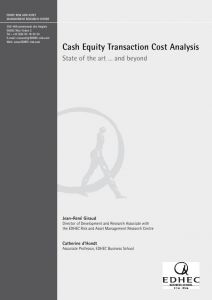

Cash Equity Transaction Cost Analysis: State of the art … and beyond
MiFID is the second step in the harmonization of the European capital markets industry and intends to adapt the first Investment Services Directive (ISD 1 issued in 1993) to the realities of the current market structures. After having clarified the nature of the new regulation, this paper first describes the role of Transaction Cost Analysis in the fulfilment of the best execution obligation as well as the limits of existing frameworks. Then, the paper presents a new methodology that makes it possible to measure the quality of execution as part of peer group review and identify whether the broker, trader or algorithm has implemented the execution too aggressively or too slowly. This approach relies on a couple of indicators allowing an easy comparison of a large universe of trades and providing insightful information not only about the final performance (EBEX absolute indicator) but also about the possible justification of the performance (EBEX direction). In order to illustrate both the framework and the level of interpretation made possible, the results of a preliminary study conducted on 2737 orders on Euronext blue chips over a 4-month sample period are reported. A revisited version of this paper was published in the November 2006 issue of the Journal of Asset Management.
Author(s):
Summary:
MiFID is the second step in the harmonization of the European capital markets industry and intends to adapt the first Investment Services Directive (ISD 1 issued in 1993) to the realities of the current market structures. After having clarified the nature of the new regulation, this paper first describes the role of Transaction Cost Analysis in the fulfilment of the best execution obligation as well as the limits of existing frameworks. Then, the paper presents a new methodology that makes it possible to measure the quality of execution as part of peer group review and identify whether the broker, trader or algorithm has implemented the execution too aggressively or too slowly. This approach relies on a couple of indicators allowing an easy comparison of a large universe of trades and providing insightful information not only about the final performance (EBEX absolute indicator) but also about the possible justification of the performance (EBEX direction). In order to illustrate both the framework and the level of interpretation made possible, the results of a preliminary study conducted on 2737 orders on Euronext blue chips over a 4-month sample period are reported. A revisited version of this paper was published in the November 2006 issue of the Journal of Asset Management.
Register to download PDF
Register/Log in| Type : | Working paper |
|---|---|
| Date : | 10/06/2006 |
| Keywords : |
Transaction Cost Analysis |

